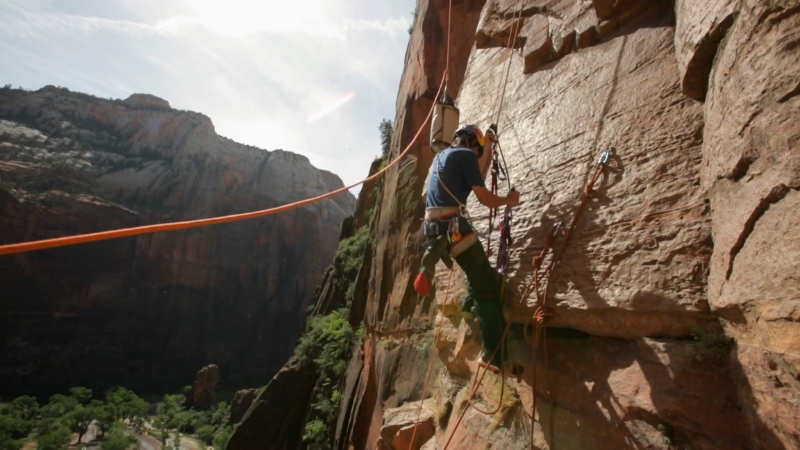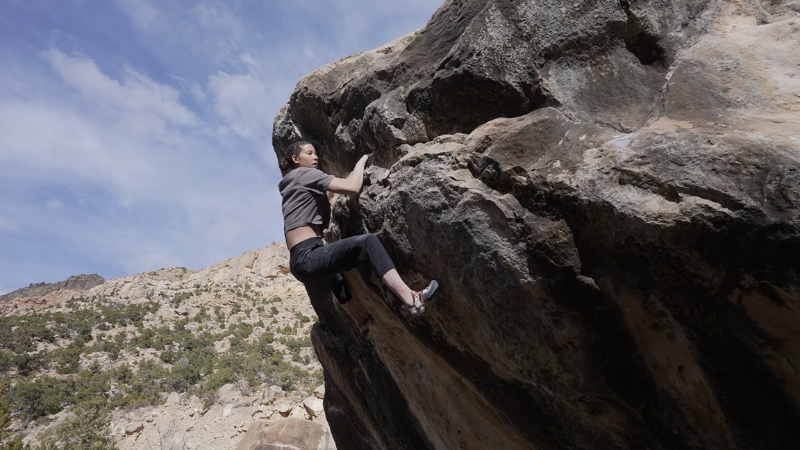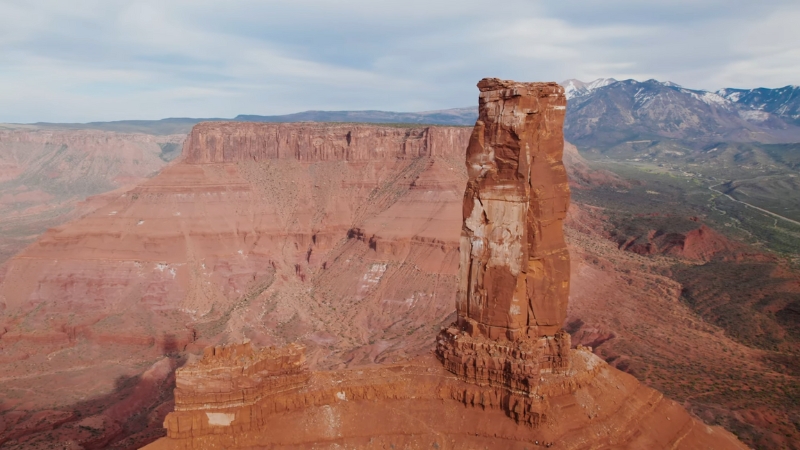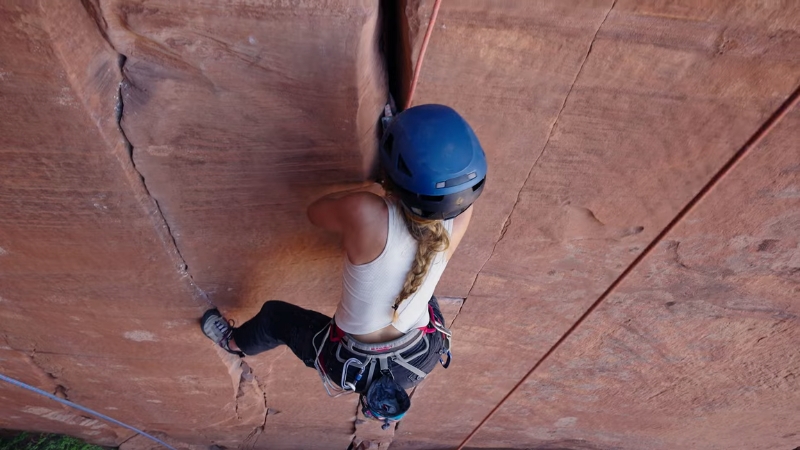Utah is the ultimate destination for rock climbing because it offers an unmatched combination of diverse rock types, world-renowned climbing areas, year-round climbing seasons, breathtaking landscapes, and a deeply rooted climbing culture.
From the iconic sandstone towers of Moab to the limestone crags of American Fork and the granite walls of Little Cottonwood Canyon, Utah presents a rock climbing paradise that caters to climbers of all styles, skill levels, and ambitions.
Whether you’re a seasoned trad climber looking to test your mettle on classic desert cracks or a boulderer in search of the next problem, Utah delivers the terrain, climate, and community that make it one of the premier climbing destinations in the world.
Let’s break down exactly what makes Utah a mecca for climbers from around the globe:
Incredible Geologic Diversity
One of the most unique aspects of climbing in Utah is the sheer diversity of rock types and formations. Each climbing destination within the state offers a completely different climbing experience due to its geology:
This incredible variety allows climbers to explore different styles and continually push their skills.
World-Class Climbing Areas in Utah
Indian Creek (Canyonlands)
Feature
Details
Rock Type
Sandstone (Navajo)
Climbing Style
Trad only (crack climbing)
Route Length
Mostly single pitch
Gear Needed
Full cam rack (multiples of the same size)
Difficulty Range
5.9 – 5.13+
Best Season
Spring, Fall
Camping Available
Yes (BLM and paid campgrounds nearby)
Notable Routes
Supercrack, Generic Crack, Scarface
Indian Creek consists of vertical sandstone walls with near-uniform parallel cracks.
Face holds are rare; climbs are pure crack lines requiring solid hand/finger jamming techniques. Protection is entirely gear-based—climbers often bring 4–6 cams of the same size for a single route. Popular sizes: #0.5 to #4 (Camalot).
Tape gloves are highly recommended. No cell service. No water sources at the crags—must bring all water.
Rest days can be spent in nearby Moab (60 min drive). Closures for raptor nesting (usually spring) affect some walls like Battle of the Bulge and Cat Wall.
Zion National Park
Feature
Details
Rock Type
Sandstone (Navajo)
Climbing Style
Trad, Aid, Multi-pitch
Route Length
4 to 15 pitches (up to 2,000 ft)
Gear Needed
Full trad rack + aid gear for harder routes
Difficulty Range
5.9 – 5.13+, C1–C3
Best Season
Spring, Fall
Camping Available
Yes (watchman, South Campground nearby)
Notable Routes
Moonlight Buttress, Spaceshot, Touchstone
Zion’s walls are massive and mostly vertical or overhung. Climbs often require hauling, route-finding, and retreat strategy.
Moonlight Buttress is the most popular free big wall (5.12+), but aid climbers can tackle it around C1. Many routes have bushy, ledgy starts and are not straightforward.

Afternoon sun can be intense—most parties start early. Permits are required for overnight climbs and bivvies.
Flash floods are a serious risk in slot canyons—check forecasts. Local ethics discourage excessive bolting; gear anchors are preferred. Rock is soft—place protection carefully.
Moab & Castle Valley
Feature
Details
Rock Type
Wingate Sandstone
Climbing Style
Trad (tower climbing, cracks)
Route Length
2–5 pitches (towers)
Gear Needed
Full rack, long slings
Difficulty Range
5.8 – 5.12
Best Season
Spring, Fall
Camping Available
Yes (dispersed and paid camping near Moab)
Notable Routes
Kor-Ingalls (Castleton), Fine Jade, Honeymoon Chimney
Castle Valley is the most accessible desert tower zone near Moab. Classic routes like Kor-Ingalls (5.9) and Fine Jade (5.11a) are frequently climbed and polished in places.
View this post on Instagram
Routes often have sandy chimneys, wide cracks (bring #5/#6 cams), and mandatory rappels from fixed anchors (usually chains or slings). Wind and lightning are common risks on summits.
Many climbs have long approach trails (30–90 min) with light scrambling. Some formations require 4WD to access trailheads. Water and services available in Moab (30–40 min). Climbers should inspect rap anchors; many are weathered.
Little Cottonwood Canyon
Feature
Details
Rock Type
Granite
Climbing Style
Trad, Sport, Multi-pitch
Route Length
1–4 pitches
Gear Needed
Mixed (cams + bolts)
Difficulty Range
5.6 – 5.12+
Best Season
Late Spring to Fall
Camping Available
No (nearby city lodging or campgrounds)
Notable Routes
Pentapitch, The Fin, Schoolroom
Little Cottonwood’s granite is compact and technical, with slabby faces, cracks, and arêtes.
Routes like Pentapitch are moderate and popular; others like The Coffin offer hard cracks. Many climbs are in the sun until midday—start early. Approaches are short but often steep or scree-covered.

Bolts are sparse on older routes; route-finding is essential.
Cell service is available throughout the canyon. No camping is allowed in the canyon, but downtown Salt Lake City is 20 minutes away. Frequent afternoon thunderstorms in summer.
Big Cottonwood Canyon
Feature
Details
Rock Type
Quartzite
Climbing Style
Trad, Sport
Route Length
1–3 pitches
Gear Needed
Standard rack + draws
Difficulty Range
5.7 – 5.12
Best Season
Summer to Fall
Camping Available
Limited (developed sites nearby)
Notable Routes
Dead Snag, Challenge Buttress, Storm Mountain
Quartzite is sharp, brittle in places, and very different from granite. Holds are mostly edges and sidepulls with occasional cracks.
Protection is often tricky to place due to flaring rock. Most routes are short, vertical, and have walk-off or rap descents. Some older sport routes have widely spaced bolts.
Afternoon shade is available on many walls. Popular with after-work climbers due to proximity to the city. Slippery when wet—avoid climbing after rain.
Parking is limited in peak season. Frequent wildlife sightings (moose, deer) near crags.
Maple Canyon
Feature
Details
Rock Type
Conglomerate
Climbing Style
Sport (steep, overhanging)
Route Length
Mostly single pitch
Gear Needed
Quickdraws only
Difficulty Range
5.8 – 5.14
Best Season
Summer
Camping Available
Yes (in-canyon camping and dispersed)
Notable Routes
Pipeline, The Pipe Dream, Killing Fields
Routes are steep and overhanging with cobblestone holds of varying stability.
Newer routes tend to have better bolt spacing; older ones may need long draws to reduce drag. Many climbs are in the 5.11–5.13 range, but there are quality moderates too.
@deannamolenda King Line, 5.12b / 7b , Maple Canyon #utah #climbing #fyp #strongwomen ♬ original sound – Deanna Molenda
Humidity is low, but the shade is critical—some walls don’t get sun until the afternoon. Water is available in campgrounds but limited elsewhere.
Approaches are short and well-marked. Ideal area for group trips and projecting due to soft landings and easy logistics. Cell service is poor inside the canyon.
Joe’s Valley
Feature
Details
Rock Type
Sandstone
Climbing Style
Bouldering
Route Height
10–20 feet (mostly)
Gear Needed
Crash pads
Difficulty Range
V0 – V15
Best Season
Spring, Fall
Camping Available
Yes (free and developed campgrounds)
Notable Problems
The Angler, Big Joe, Kill by Numbers
Joe’s is split into Left Fork, Right Fork, and New Joe’s—each with hundreds of problems. Most boulders have flat landings, but multiple pads are still recommended.

Winter snow limits access Dec–Feb. Cell service is limited in the canyons. Local shops in Orangeville and Castle Dale have food and fuel.
The Joe’s Valley Bouldering Festival is held annually and brings in hundreds of climbers. Chalk use is heavy—bring a brush to clean holds and preserve the rock.
Climbing Year-Round
Utah’s range of elevations, from low-elevation desert to alpine canyons above 9,000 feet, allows for year-round climbing.
Each season has optimal zones based on temperatures, sun exposure, and weather stability.
Season
Best Areas
Conditions
Winter
St. George, Zion, Red Cliffs
Low desert elevation (2,000–4,000 ft), dry and sunny. Daytime temps average 45–60°F. Little to no snow.
Spring
Moab, Indian Creek, Castle Valley
Ideal temps (50–75°F), dry, stable weather. Snow melt opens dirt road access to many crags.
Summer
Little Cottonwood, American Fork, Maple Canyon
Higher elevation (6,000–9,000 ft), shaded routes, lower humidity. Daytime highs 70–85°F.
Fall
Moab, Indian Creek, Zion
Dry weather returns, ideal crack and big wall conditions, lower crowds. Temps 50–75°F.
Route access and crag usability change significantly with the seasons.
For example, Indian Creek and Castle Valley are inaccessible or unpleasant in mid-summer due to extreme heat (90–100°F+).
In contrast, Maple Canyon and Little Cottonwood remain climbable in July and August due to their elevation and shaded walls.
Snow affects access in northern Utah crags (e.g., Little/Big Cottonwood) typically from November to April.
Accessibility and Infrastructure

Utah has climbing areas located within close range of major transportation, accommodations, and services, making it one of the easiest U.S. states to plan extended trips or quick weekend climbing.
Factor
Details
Closest Airport
Salt Lake City International (SLC) – 20 mins from Little Cottonwood
Closest Major Climbing Towns
Moab (Indian Creek, Castle Valley), St. George (Snow Canyon, Moe’s), Springdale (Zion)
Camping
BLM land (free dispersed), developed campgrounds, RV parks, USFS sites
Lodging
Hotels and Airbnbs widely available in Moab, Salt Lake, St. George
Guide Services
Licensed guides in Moab, Zion, St. George, and Salt Lake area
Gear Shops
Gearheads (Moab), The Front Climbing Club (SLC), Desert Rat (St. George)
Many crags are within 15–60 minutes of towns with full services, including groceries, showers, gas, and gear rental.
Dispersed camping is permitted on most BLM land near Indian Creek, Castle Valley, and Joe’s Valley.
Areas like Indian Creek and Castle Valley have no cell service, no water sources, and limited emergency access—self-sufficiency is required.
Natural Environment and Surroundings
Utah’s climbing terrain spans five national parks, multiple national forests, and tens of thousands of acres of BLM and state land. Climbers encounter a range of natural environments depending on location and elevation.
Region
Elevation Range
Terrain
Considerations
Indian Creek
4,500–5,500 ft
Open desert, sandstone cliffs
No natural water, exposed to sun, remote
Zion
3,900–7,000 ft
Canyon walls, mixed vegetation
Flash flood risk, wildlife, permits required
Moab & Castle Valley
4,000–6,000 ft
Buttes, towers, mesa plateaus
Sandy approaches, loose rock possible
Joe’s Valley
6,000–7,500 ft
Forested river canyon
Cold mornings, variable winter access
Maple Canyon
6,500–7,200 ft
Forested canyon, steep walls
Limited sun, access road seasonal
Little/BCC
5,800–7,500 ft
Alpine canyons, granite/quartzite
Frequent storms, no camping in canyon
Climbers should be prepared for elevation-related temperature swings. Wildlife (bears, moose, snakes) are common in many zones. Some areas (e.g., Zion, Indian Creek) experience annual closures due to peregrine falcon nesting.
Terrain is often rugged and undeveloped—good footwear and navigation are essential. Snow may block access to high-elevation areas into late spring.
Climbing History, Stewardship, and Access
Climbing goals and frustration https://t.co/9whWn9kJhv pic.twitter.com/rNeUnr2NZ6
— steph davis (@highsteph) April 12, 2016
Utah has played a significant role in North American climbing history. Development in areas like Zion and Castle Valley began in the 1960s and continues today under evolving ethics and land use policies.
Aspect
Details
Historical Climbers
Layton Kor (Zion/Castleton), Harvey Carter, Steph Davis, Alex Honnold
Notable First Ascents
Moonlight Buttress (1971), Kor-Ingalls Route (1961)
Access Organizations
Salt Lake Climbers Alliance, Friends of Indian Creek, Access Fund
Land Managers
BLM, National Park Service, US Forest Service
Key Concerns
Bolt chopping, fixed anchor policy, human waste, overcrowding
Climbers are expected to follow Leave No Trace and fixed anchor guidelines.
Poop tubes are required in many desert areas due to lack of decomposition. Anchors in national parks must follow strict permit and replacement policies.
Indian Creek is under increased scrutiny due to traffic and environmental impact—many local groups organize annual cleanup and trail maintenance days.
Climbers are responsible for knowing access rules, including raptor closures and road conditions.
Climbing for All Levels and Styles

Utah’s climbing covers every discipline—sport, trad, aid, bouldering, and alpine—at all skill levels.
Level
Areas & Routes
Beginner
Big Cottonwood (Dead Snag, Dogwood), Moe’s Valley (V0–V2), American Fork (5.6–5.9 sport)
Intermediate
Indian Creek (Generic Crack, Blue Sun), Castle Valley (Kor-Ingalls), Maple Canyon (5.10–11 sport)
Advanced
Moonlight Buttress (Zion), Pipe Dream (Maple), Black Dahlia (Joe’s V12), Fine Jade (5.11c)
Many areas offer overlap between styles.
Style
Key Locations
Trad
Indian Creek, Castle Valley, Zion, Little Cottonwood
Sport
Maple Canyon, American Fork, St. George
Bouldering
Joe’s Valley, Moe’s Valley
Multi-pitch
Zion, Little Cottonwood, Castle Valley
Aid
Zion (Spaceshot, Prodigal Sun), Kolob Canyons
For example, Little Cottonwood has both trad and sport, while Castle Valley towers may require a chimney, off-width, and face climbing. Beginners should avoid Indian Creek until they are comfortable placing gear and crack climbing.
If you’re looking for a unique experience, the Hidden Slot Canyons in Utah offer stunning, narrow paths that are perfect for a different type of adventure.
Advanced climbers looking to project can find 5.14 sport routes in Maple Canyon or V14s in Joe’s Valley.
Most climbing is single-pitch, but Utah has dozens of multi-pitch lines over 500 ft.

